2001 年 6 月英语六级真题及答案
Part I Listening Comprehension (20 minutes)
Section A
Directions: Inthissection,youwillhear10shortconversations.Attheendofeach
conversation, a question will be asked about what was said. Both the
conversationandthequestionwillbespokenonlyonce.Aftereachquestion
therewillbeapause.Duringthepause,youmustreadthefourchoicesmarked
A), B), C) and D), and decide which is the best answer. Then mark the
corresponding letter on the Answer Sheet with a single line through the
centre.
Example:
You will hear:
You will read:
A) 2 hours.
B) 3 hours.
C) 4 hours.
D) 5 hours.
From the conversation we know that the two are talking about some work they will
start at 9 o’clock in the morning and have to finish at 2 in the afternoon. Therefore,
D) “5 hours” is the correct answer. You should choose [D] on the Answer Sheet and
mark it with a single line through the centre.
Sample Answer [A] [B] [C] [D]
1.
A) He will tell Mary how to operate the dishwasher.
B) He will wash the dishes himself instead.
C) He will help Bill to translate the manual.
D) He himself will operate the dishwasher.
2.
A) Lose weight.
B) Quit smoking.
C) Weigh himself frequently.
D) Have a talk with the doctor.
3.
A) The woman should have complained to her neighbor.
B) The woman should stay out until the neighbors are quiet.
C) The woman should have stayed at the library.
�
D) The lab will be a better place for reading.
4.
A) Check the figures later today.
B) Do the calculations again tomorrow.
C) Bring a calculator tomorrow.
D) Calculate the number right now.
5.
A) She doesn’t remember much about the city.
B) She’s never been to the city.
C) She would find someone else to help.
D) She would talk to the man later.
6.
A) She thinks the man should have helped earlier.
B) She doesn’t need the man’s help.
C) She doesn’t know the boxes are heavy.
D) She wants the man to help with the boxes.
7.
A) She let the man use her books for the weekend.
B) She brought the books the man asked for.
C) She borrowed the books from the man.
D) She offered to help the man.
8.
A) She’d like to have the windows open.
B) She likes to have the air conditioner on.
C) The air is heavily polluted.
D) The windows are already open.
9.
A) He’s going to visit a photo studio.
B) He’s just had his picture taken.
C) He’s on the way to the theater.
D) He’s just returned from a job interview.
10. A) At a gas station.
B) In a park.
C) In an emergency room.
D) At a garage.
Section B
Directions: Inthissection,youwillhear3shortpassages.Attheendofeachpassage,
�
you will hear some questions. Both the passage and the questions will be
spokenonlyonce.Afteryouhearaquestion,youmustchoosethebestanswer
fromthefourchoicesmarkedA),B),C)andD).Thenmarkthecorresponding
letter on the Answer Sheet with a single line through the centre.
Questions 11 to 13 are based on the passage you have just heard.
Passage One
11. A) One sixth of them are seriously polluted.
B) One third of them are seriously polluted.
C) Half of them are seriously polluted.
D) Most of them are seriously polluted.
12. A) There was no garbage left to clean up.
B) There was more garbage than before and they had to work harder.
C) The river had become so clean that a lot of water-birds came back.
D) The river was much cleaner and they had to search for garbage.
13. A) Most of them would be indifferent and keep on throwing garbage into the river.
B) They would join the students in changing the situation.
C) They would become more aware of the pollution problem.
D) They would think twice before they went swimming or fishing in the river.
Questions 14 to 17 are based on the passage you have just heard.
Passage Two
14. A) Why people hold back their tears.
B) Why people cry.
C) How to restrain one’s tears.
D) How tears are produced.
15. A) What chemicals tears are composed of.
B) Whether crying really helps us feel better.
C) Why some people tend to cry more often than others.
D) How tears help people cope with emotional problems.
16. A) Only one out of four girls cries less often than boys.
B) Of four boys, only one cries very often.
C) Girls cry four times as often as boys.
�
D) Only one out of four babies doesn’t cry often.
17. A) Only humans respond to emotions by shedding tears.
B) Only humans shed tears to get rid of irritating stuff in their eyes.
C) Only human tears can resist the invading bacteria.
D) Only human tears can discharge certain chemicals.
Questions 18 to 20 are based on the passage you have just heard.
Passage Three
18. A) They make decisions by tossing coins.
B) They are not physically separated.
C) They think exactly the same way.
D) They share most of their vital organs.
19. A) Few of them can live long.
B) Few of them get along well with each other.
C) Most of them live a normal life.
D) Most of them differ in their likes and dislikes.
20. A) They go to a regular school.
B) They attend a special school.
C) They are taught by their parents.
D) They have a private tutor.
Part II Reading Comprehension (35 minutes)
Directions: There are 4 passages in this part. Each passage is followed by some
questionsorfinishedstatements.Foreachofthemtherearefourchoices
markedA),B),C)andD).Youshoulddecideonthebestchoiceandmarkthe
corresponding letter on the Answer Sheet with a single line through the
centre.
Passage One
Questions 21 to 25 are based on the following passage.
Our culture has caused most Americans to assume not only that our language is
universal but that the gestures we use are understood by everyone. We do not realize
that waving good-bye is the way to summon a person from the Philippines to one’s side,
or that in Italy and some Latin-American countries, curling the finger to oneself is
a sign of farewell.
�
Those private citizens who sent packages to our troops occupying Germany after World
War II and marked them GIFT to escape duty payments did not bother to find out that
“Gift” means poison in German. Moreover, we like to think of ourselves as friendly,
yet we prefer to be at least 3 feet or an arm’s length away from others. Latins and
Middle Easterners like to come closer and touch, which makes Americans uncomfortable.
Our linguistic(语言上的) and cultural blindness and the casualness with which we
take notice of the developed tastes, gestures, customs and languages of other countries,
are losing us friends, business and respect in the world.
Even here in the United States, we make few concessions to the needs of foreign
visitors. There are no information signs in four languages on our public buildings or
monuments; we do not have multilingual (多语言的) guided tours. Very few restaurant
menus have translations, and multilingual waiters, bank clerks and policemen are rare.
Our transportation systems have maps in English only and often we ourselves have
difficulty understanding them.
When we go abroad, we tend to cluster in hotels and restaurants where English is
spoken. Then attitudes and information we pick up are conditioned by those
natives—usually the richer—who speak English. Our business dealings, as well as the
nation’s diplomacy, are conducted through interpreters.
For many years, American dollars no longer buy all good things, and we are slowly
beginning to realize that our proper role in the world is changing. A 1979 Harris poll
reported that 55 percent of Americans want this country to play a more significant role
in world affairs; we want to have a hand in the important decisions of the next century,
even though it may not always he the upper hand.
21. It can be inferred that Americans being approached too closely by Middle Easterners
would most probably ________.
A) stand still
B) jump aside
C) step forward
D) draw back
22. The author gives many examples to criticize Americans for their ________.
A) cultural self-centeredness
B) casual manners
C) indifference towards foreign visitors
D) arrogance towards other cultures
23. In countries other than their own most Americans ________.
A) are isolated by the local people
B) are not well informed due to the language barrier
C) tend to get along well with the natives
�
D) need interpreters in hotels and restaurants
24. According to the author, Americans’ cultural blindness and linguistic ignorance
will ________.
A) affect their image in the new era
B) cut themselves off from the outside world
C) limit their role in world affairs
D) weaken the position of the US dollar
25. The author’s intention in writing this article is to make Americans realize that
________.
A) it is dangerous to ignore their foreign friends
B) it is important to maintain their leading role in world affairs
C) it is necessary to use several languages in public places
D) it is time to get acquainted with other cultures
Passage Two
Questions 26 to 30 are based on the following passage.
In department stores and closets all over the world, they are waiting. Their outward
appearance seems rather appealing because they come in a variety of styles, textures,
and colors. But they are ultimately the biggest deception that exists in the fashion
industry today. What are they? They are high heels—a woman’s worst enemy (whether
she knows it or not). High heel shoes are the downfall of modern society. Fashion myths
have led women to believe that they are more beautiful or sophisticated for wearing
heels, but in reality, heels succeed in posing short as well as long term hardships.
Women should fight the high heel industry by refusing to use or purchase them in order
to save the world from unnecessary physical and psychological suffering.
For the sake of fairness, it must be noted that there is a positive side to high
heels. First, heels are excellent for aerating(使通气) lawns. Anyone who has ever worn
heels on grass knows what I am talking about. A simple trip around the yard in a pair
of those babies eliminates all need to call for a lawn care specialist, and provides
the perfect-sized holes to give any lawn oxygen without all those messy chunks of dirt
lying around. Second, heels are quite functional for defense against oncoming enemies,
who can easily be scared away by threatening them with a pair of these sharp, deadly
fashion accessories.
Regardless of such practical uses for heels, the fact remains that wearing high
heels is harmful to one’s physical health. Talk to any podiatrist (足病医生), and
you will hear that the majority of their business comes from high-heel-wearing women.
High heels are known to cause problems such as deformed feet and torn toenails. The
risk of severe back problems and twisted or broken ankles is three times higher for
a flat shoe wearer. Wearing heels also creates the threat of getting a heel caught in
�
a sidewalk crack or a sewer-grate (阴沟栅) and being thrown to the ground—possibly
breaking a nose, back, or neck. And of course, after wearing heels for a day, any woman
knows she can look forward to a night of pain as she tries to comfort her swollen, aching
feet.
26. What makes women blind to the deceptive nature of high heels?
A) The multi-functional use of high heels.
B) Their attempt to show off their status.
C) The rich variety of high heel styles.
D) Their wish to improve their appearance.
27. The author’s presentation of the positive side of high heels is meant ________.
A) to be ironic
B) to poke fun at women
C) to be fair to the fashion industry
D) to make his point convincing
28. The author uses the expression “those babies” (Line 3, Para. 2) to refer to high
heels ________.
A) to show their fragile characteristics
B) to indicate their feminine features
C) to show women’s affection for them
D) to emphasize their small size
29. The author’s chief argument against high heels is that ________.
A) they pose a threat to lawns
B) they are injurious to women’s health
C) they don’t necessarily make women beautiful
D) they are ineffective as a weapon of defense
30. It can be inferred from the passage that women should ________.
A) see through the very nature of fashion myths
B) boycott the products of the fashion industry
C) go to a podiatrist regularly for advice
D) avoid following fashion too closely
Questions 31 to 35 are based on the following passage.
Passage Three
�
It is hardly necessary for me to cite all the evidence of the depressing state of
literacy. These figures from the Department of Education are sufficient: 27 million
Americans cannot read at all, and a further 35 million read at a level that is less
than sufficient to survive in our society.
but my own worry today is less that of the overwhelming problem of elemental literacy
than it is of the slightly more luxurious problem of the decline in the skill even of
the middle-class reader, of his unwillingness to afford those spaces of silence, those
luxuries of domesticity and time and concentration, that surround the image of the
classic act of reading. It has been suggested that almost 80 percent of America’s
literate, educated teenagers can no longer read without an accompanying noise (music)
in the background or a television screen flickering(闪烁) at the corner of their field
of perception. We know very little about the brain and how it deals with simultaneous
conflicting input, but every common-sense intuition suggests we should be profoundly
alarmed. This violation of concentration, silence, solitude (独处的状态) goes to the
very heart of our notion of literacy; this new form of part-reading, of part-perception
against background distraction, renders impossible certain essential acts of
apprehension and concentration, let alone that most important tribute any human being
can pay to a poem or a piece of prose he or she really loves, which is to learn it by
heart. Not by brain, by heart; the expression is vital.
Under these circumstances, the question of what future there is for the arts of
reading is a real one. Ahead of us lie technical, psychic ( 心 理 的 ), and social
transformations probably much more dramatic than those brought about by Gutenberg, the
German inventor in printing. The Gutenberg revolution, as we now know it, took a long
time; its effects are still being debated. The information revolution will touch every
fact of composition, publication, distribution, and reading. No one in the book industry
can say with any confidence what will happen to the book as we’ve known it.
31. The picture of the reading ability of the American people, drawn by the author,
is ________.
A) rather bleak
B) fairly bright
C) very impressive
D) quite encouraging
32. The author’s biggest concern is ________.
A) elementary school children’s disinterest in reading classics
B) the surprisingly low rate of literacy in the U.S.
C) the musical setting American readers require for reading
D) the reading ability and reading behavior of the middle class
33. A major problem with most adolescents who can read is ________.
A) their fondness of music and TV programs
�
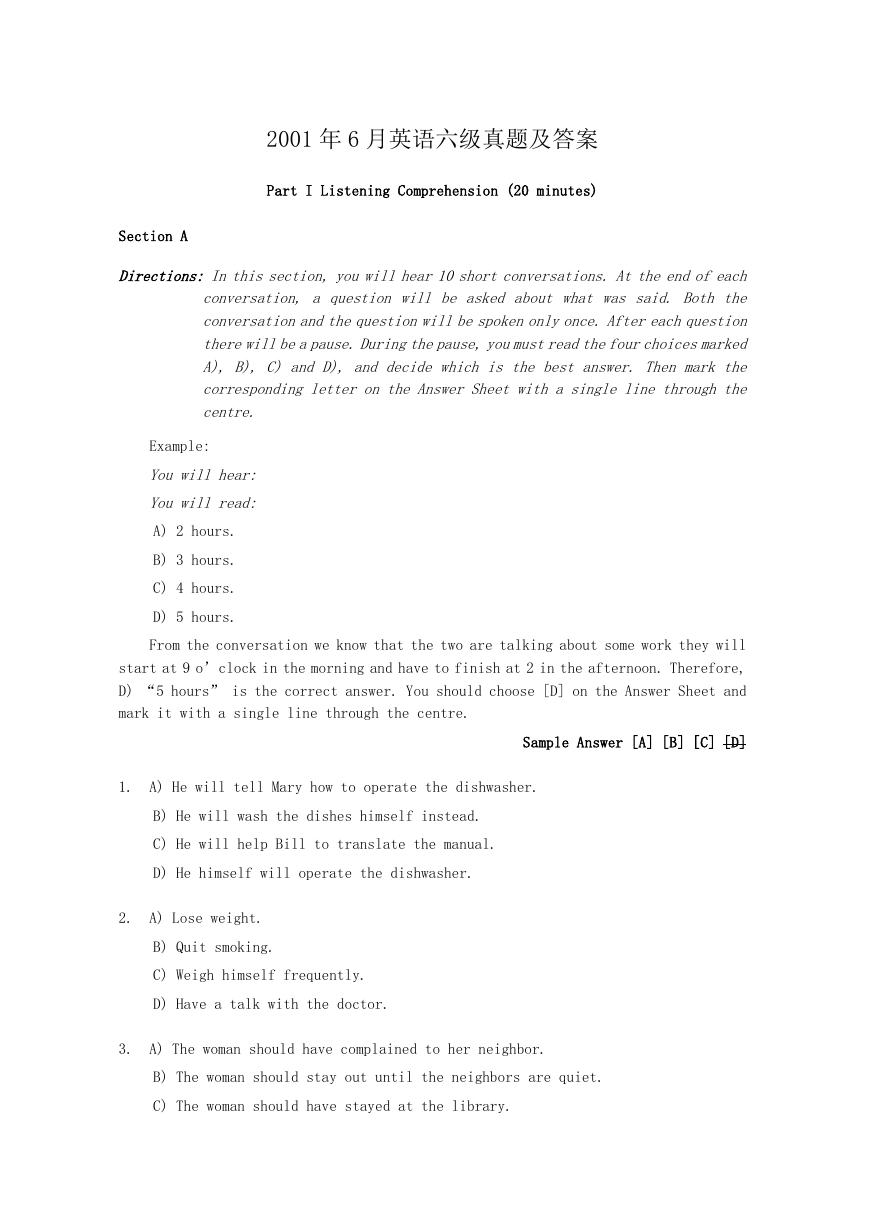
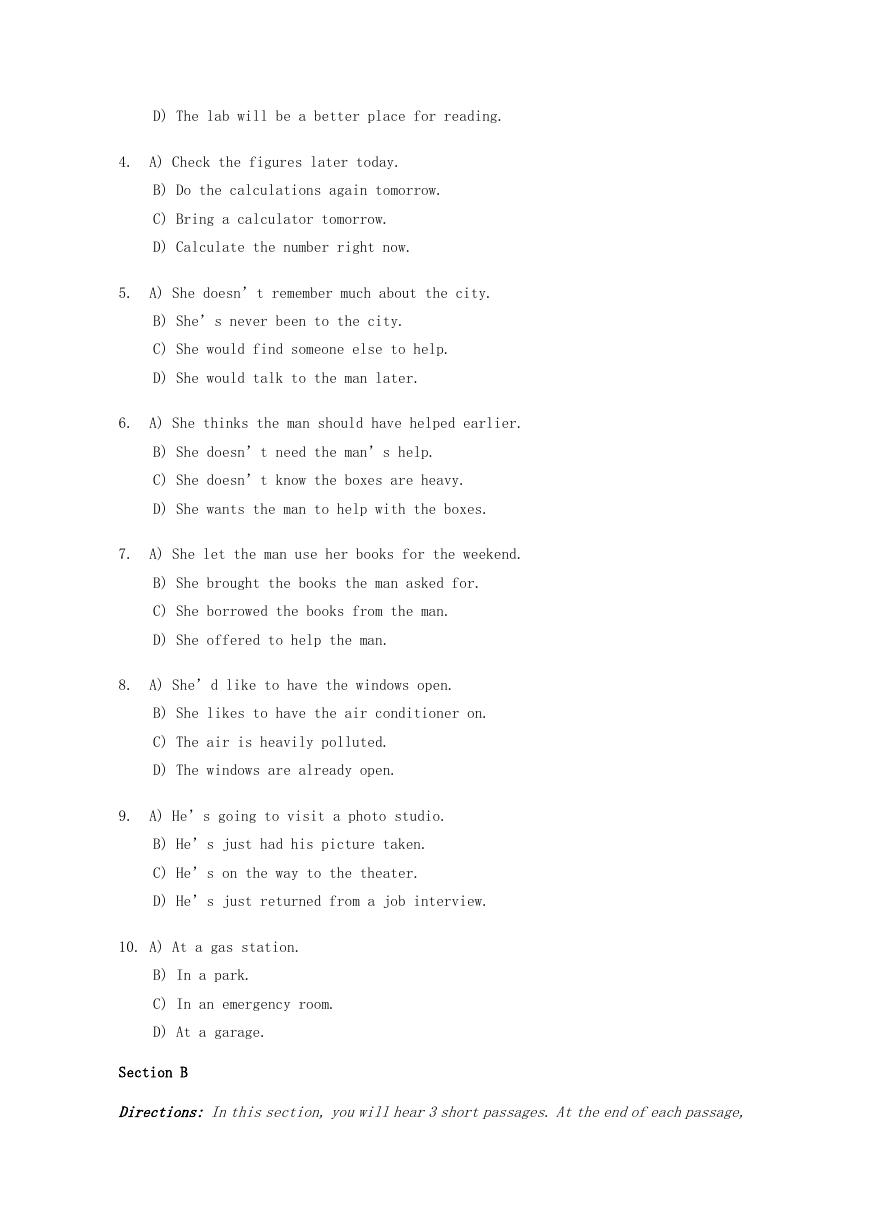
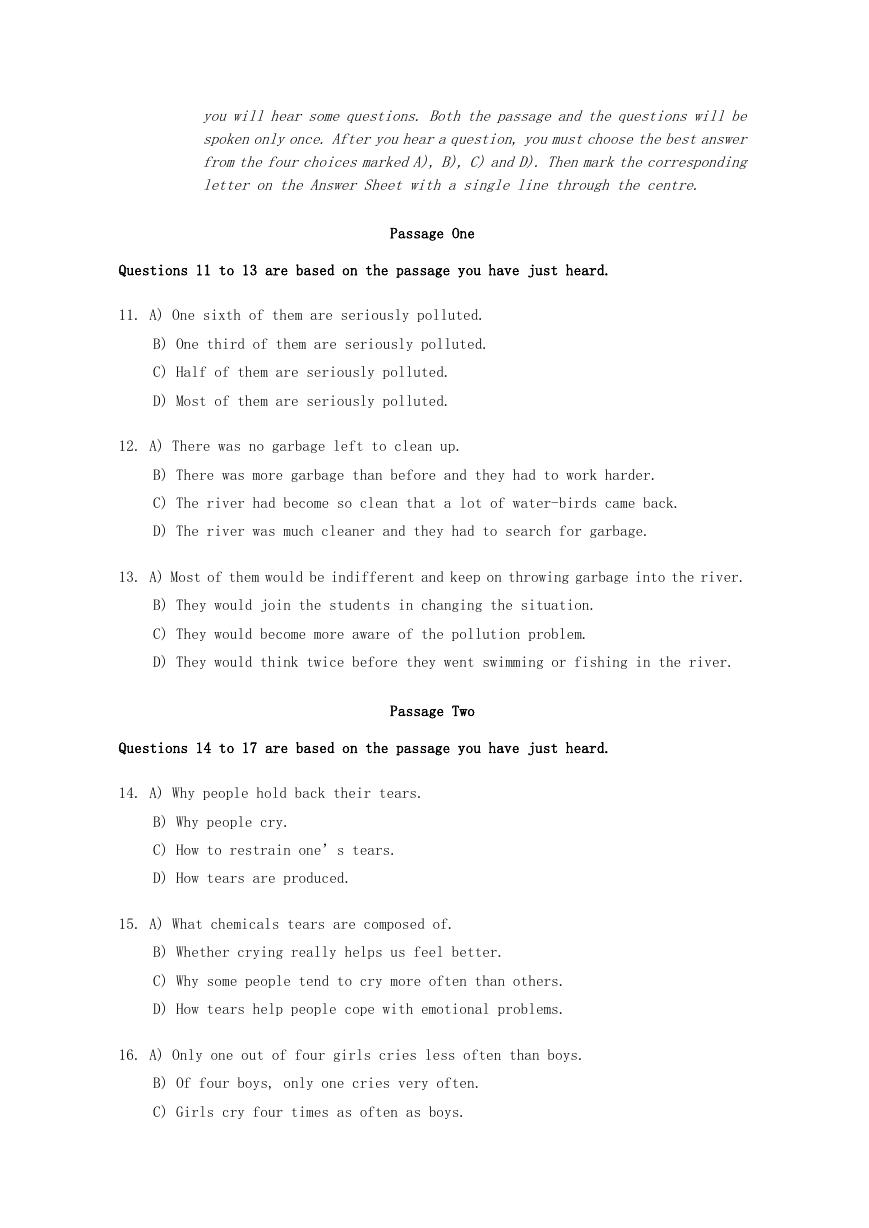
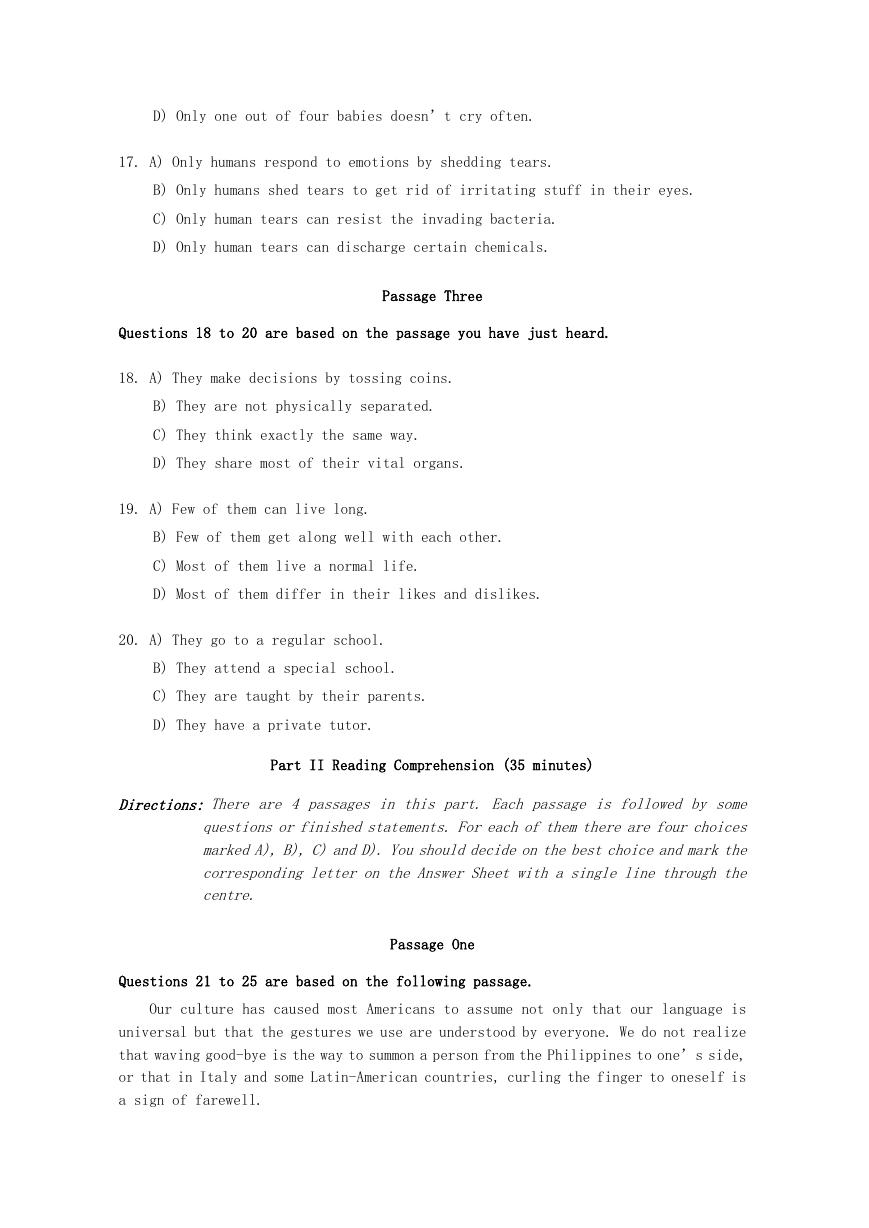
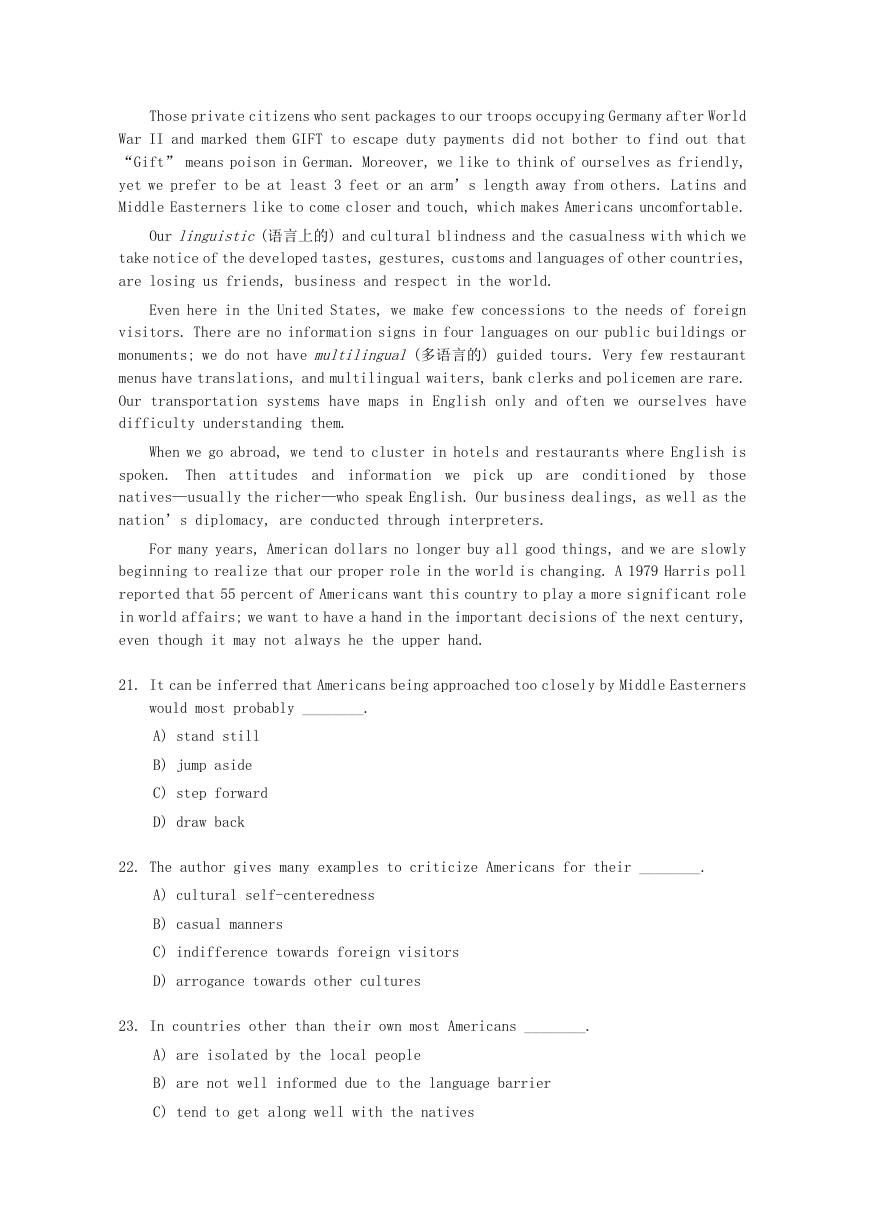

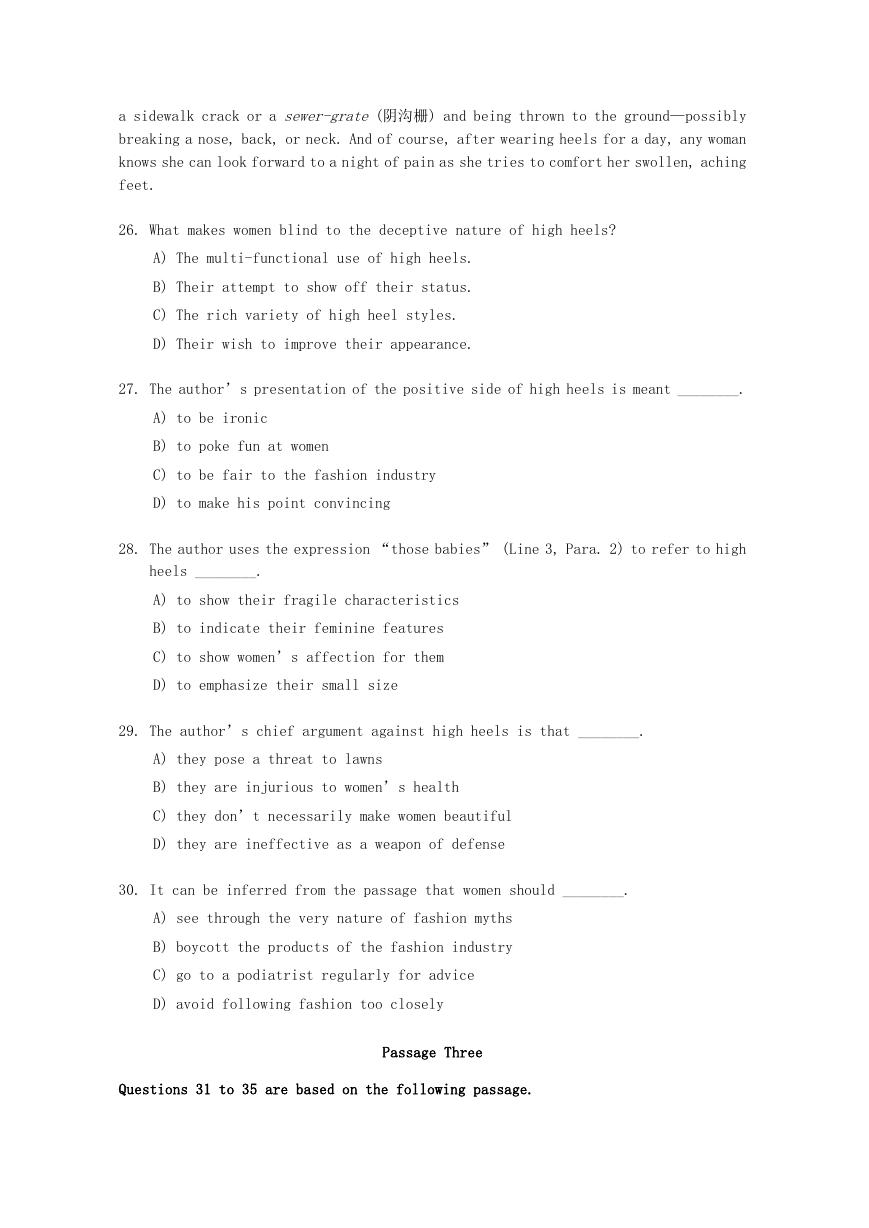









 2023年江西萍乡中考道德与法治真题及答案.doc
2023年江西萍乡中考道德与法治真题及答案.doc 2012年重庆南川中考生物真题及答案.doc
2012年重庆南川中考生物真题及答案.doc 2013年江西师范大学地理学综合及文艺理论基础考研真题.doc
2013年江西师范大学地理学综合及文艺理论基础考研真题.doc 2020年四川甘孜小升初语文真题及答案I卷.doc
2020年四川甘孜小升初语文真题及答案I卷.doc 2020年注册岩土工程师专业基础考试真题及答案.doc
2020年注册岩土工程师专业基础考试真题及答案.doc 2023-2024学年福建省厦门市九年级上学期数学月考试题及答案.doc
2023-2024学年福建省厦门市九年级上学期数学月考试题及答案.doc 2021-2022学年辽宁省沈阳市大东区九年级上学期语文期末试题及答案.doc
2021-2022学年辽宁省沈阳市大东区九年级上学期语文期末试题及答案.doc 2022-2023学年北京东城区初三第一学期物理期末试卷及答案.doc
2022-2023学年北京东城区初三第一学期物理期末试卷及答案.doc 2018上半年江西教师资格初中地理学科知识与教学能力真题及答案.doc
2018上半年江西教师资格初中地理学科知识与教学能力真题及答案.doc 2012年河北国家公务员申论考试真题及答案-省级.doc
2012年河北国家公务员申论考试真题及答案-省级.doc 2020-2021学年江苏省扬州市江都区邵樊片九年级上学期数学第一次质量检测试题及答案.doc
2020-2021学年江苏省扬州市江都区邵樊片九年级上学期数学第一次质量检测试题及答案.doc 2022下半年黑龙江教师资格证中学综合素质真题及答案.doc
2022下半年黑龙江教师资格证中学综合素质真题及答案.doc